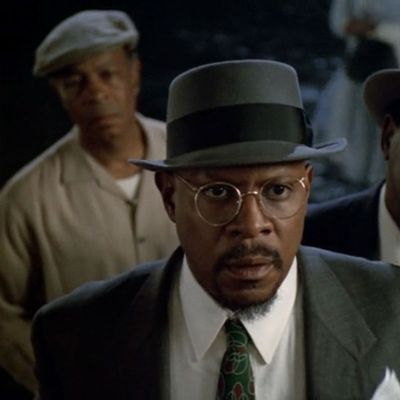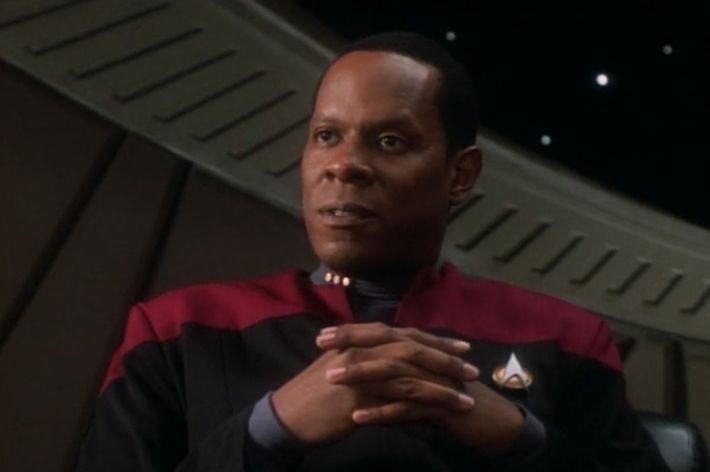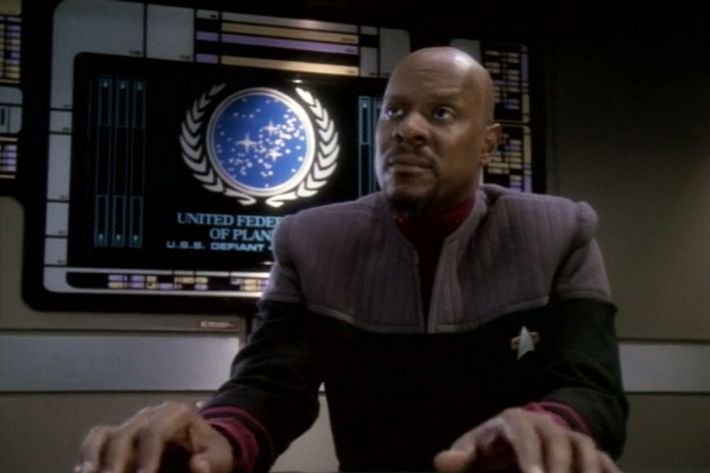
When Star Trek: Deep Space Nine premiered 25 years ago, it was entering into a storied science-fiction enterprise that prized camaraderie and intellectual curiosity. Almost immediately, Deep Space Nine set itself apart from its predecessors. If previous incarnations saw their story lines born from a place of peace and exploration, Deep Space Nine was born of the fires of war. No incarnation of Star Trek before or since has lived up the ideals of diversity quite the way Deep Space Nine did over the course of its seven seasons. The series introduced the franchise’s first black lead in the form of Commander (and later Captain) Benjamin Sisko (Avery Brooks), a widow, single father, and religious icon to the Bajoran people who is tasked with bringing the newly freed people of Bajor into the Federation while heading a space station at the edge of a previously undiscovered wormhole. (If you want more details, take a look at my guide to every Star Trek show.)
Deep Space Nine isn’t only notable for its diversity though. The show favored long-form arcs, which allowed its stories to be as emotionally resonant as they were politically profound. It is a beautifully acted, impactfully directed, and resolutely gritty show. Rewatching Deep Space Nine in 2018 has shown me that its artistry feels more relevant than ever today, which makes a list like this difficult to write. In honor of its 25th anniversary, here are the top 15 episodes of Deep Space Nine, all available on Hulu.
15. “Past Tense Part 1 & 2” Season 3, Episode 11 & 12
Since its beginnings, science fiction has used all manner of ghouls, aliens, monsters, and madmen as allegory to interrogate real-world concerns. The Star Trek universe reflects this history, but in doing so, sometimes the complexity and tangled nature of certain social concerns get lost in translation. Deep Space Nine often made the bold decision to eschew allegory and instead tackle race, poverty, and identity with a more gimlet-eyed approach, which gave us episodes like the season three two-parter, “Past Tense.” In it, Sisko, science officer Lieutenant Jadzia Dax (a luminescent Terry Farrell), and Dr. Julian Bashir (the always amazing Alexander Siddig) are thrust about 300 years into the past because of a transporter malfunction. San Francisco in 2024 is a harrowing landscape in which the homeless are sectioned off from society, poverty is rampant, and racism is still very much a reality. It’s fascinating watching how each Starfleet officer contends with the thorny political moment as well as the lengths Sisko goes to ensure that the future remains intact. As men of color, Sisko and Bashir contend with racism in ways they never have to in their daily lives, as it is a thing of the past in Earth’s 24th century. As Robert Greene II wrote for the Atlantic, “‘Past Tense’ was notable for depicting racism not from the perspective of a well-meaning white liberal, as seen in previous iterations of Star Trek, but through the eyes of people of color directly threatened by violence and indifference.”
14. “Whispers” Season 2, Episode 14

What makes Deep Space Nine such an amazing series are its rich performances from a cast of actors with no weak links, adding an important dimension to the emotional reality of the series. This is true of everyone from silent supporting figures like Morn to crucial antagonists like Kai Winn to Starfleet officers like Chief of Operations Miles O’Brien (Colm Meaney), who was introduced on The Next Generation but came into his own on Deep Space Nine. Many episodes that focus on O’Brien put him through an existential, often surreal hell. “Whispers” is definitely part of that tradition, as O’Brien returns from an away mission to find his wife, Keiko (Rosalind Chao), and his colleagues treating him with strange suspicion. Taking inspiration from films like The Parallax View and Invasion of the Body Snatchers, “Whispers” creates a miasma of dread that builds to a gut punch of a surprise ending.
13. “Duet” Season 1, Episode 19
The first season of Deep Space Nine is notoriously rocky, as the writers and cast were still finding the right balance between acknowledging the history they were entering into and establishing the show as its own beast. “Duet” crystallizes the transcendence of the series as the writers smartly established the emotional lives of each character as important, making the political and historical commentary resonate on a deeper level. “Duet” fleshes out one of the best characters in the series, Kira Nerys (a fierce Nana Visitor), a Bajoran former freedom fighter (or terrorist, depending on who you ask) who now acts as the first officer aboard the station. She confronts the past of her people when a Cardassian she suspects to be a war criminal boards the station looking for medical help. “Duet” eschews any subplot to focus entirely on the morality play between Kira and a man she believes is responsible for hideous crimes against her people during the war. In doing so, it introduces a host of fascinating themes about the nature of war and its aftermath that are consistently explored throughout the run of the series.
12. “The Siege AR-558” Season 7, Episode 8
Despite my intense love of this series, I have a strange relationship with its final season. Most of that is because of the loss of my personal favorite character, Jadzia, whose final-season replacement lacks her complexity and throws off the balance of the narrative. But season seven has many stellar episodes, especially the barbed “The Siege of AR-558,” the darkest entry in the series’ exploration of the perils of wars and the moral compromises made in order to achieve victory. Sisko decides to help a group of downtrodden Starfleet officers fighting to protect an important outpost, and the episode is granted great dimension because of his willingness to cross lines to find success (along with the impressive guest turns). Coupled with the direction of Winrich Kolbe, who used his past as a Vietnam veteran to shape the visual grammar, it’s a thought-provoking and brutal episode that shows the depth of Deep Space Nine’s moral complexity.
11. “The Magnificent Ferengi” Season 6, Episode 10
Deep Space Nine is typically considered a hard-hitting, gritty entry in Star Trek’s canon. While this is definitely true, some of my favorite episodes are when it decides to embrace its pulpier sensibilities. Many of the most hilarious episodes center on the underhanded yet empathetic bar owner Quark (Armin Shimerman), and such is the case with “The Magnificent Ferengi.” In it, Quark forms a ragtag group of Ferengi to rescue his mother from the Dominion, the overarching big bad of the series headed by the Changelings. It’s a blissfully bonkers episode showcasing the comedic talents of the supporting cast, with Jeff Combs especially being a highlight. Plus, it has a guest turn by none other than Iggy Pop.
10. “For the Uniform” Season 5, Episode 13
At what point does the Federation’s interest in expanding a peacekeeping group of planets and influence turn into colonization? This is the question the franchise as a whole hasn’t properly considered despite the obvious military aspects to Starfleet and the writers’ interest in philosophy. Deep Space Nine tackles this directly through the arc of Michael Eddington, a Starfleet officer who betrays his duty while serving under Sisko in order to join a rebel group, known as the Maquis, disgruntled about the Federation’s practices.
9. “Sacrifice of Angels” Season 6, Episode 6
If I had my way, nearly the entirety of the sixth season would be on this list. It’s that good. The beginning of the season sees the main crew embroiled in a fierce war with the Dominion. “Sacrifice of Angels” culminates a crucial six-episode arc as Sisko makes a bold attempt to reclaim Deep Space Nine from Dominion influence. It’s bracing and profound, showcasing the most spectacular large-scale battle in Star Trek TV history. But it isn’t the bombast that lands the “Sacrifice of Angels” on this list, but how Sisko’s relationship with his status as a religious icon, a crucial arc to the entire series, evolves.
8. “The Sound of Her Voice” Season 6, Episode 25

“The Sound of Her Voice” has a deceptively simple premise: Aboard their warship USS Defiant, the main crew gets a distress call from a lone Starfleet captain (Lisa Cusak, voiced by Debra Wilson) on an inhospitable planet, who will die shortly if not given proper medical care. The crew slowly forms a relationship with Lisa, partially to keep her mind off what will happen if the Defiant doesn’t arrive in time, and also to talk about the interpersonal issues they struggle to voice with those closest to them. It’s a revealing, emotionally layered episode that creates worlds of intensity simply by characters having conversations with one another. Even more impressive is that Lisa is never seen onscreen. Debra Wilson is able to create a well-rounded, humane character with only the sound of her voice.
7. “Second Skin” Season 3, Episode 5
What if you woke up with a face that is not your own and told the life you’ve been leading is a cleverly constructed lie? From the very beginning, Kira Nerys is a complex woman who ties much of her identity to being a Bajoran — her role as a freedom fighter in the war to regain her planet provides the backstory to the series. “Second Skin” centers on Kira being kidnapped by Cardassians, whom she has long viewed as enemies given their long occupation of her home planet, and told she’s really a Cardassian spy who took over the life of the real Kira Nerys, and was implanted with false memories to make the deception more authentic. Tinged with a Philip K. Dick–inspired approach to identity, “Second Skin” further evolves Kira in ways that are both poignant and existentially profound.
6. “Improbable Cause” and “The Die Is Cast” Season 3, Episode 20 & 21
The former spy turned exiled Cardassian Garak (played with wit and cunning by Andrew J. Robinson) is by far one of the best characters in all of Star Trek canon. This two-parter from season three cements the moral complexity and sharp-tongued mendacity of Garak, giving Robinson the opportunity to take center stage as he tangles with the faults of his past. Brimming with intrigue, twists, and a standout interrogation scene between Odo and Garak, it’s a stunning two-parter that shows just how astounding Deep Space Nine could be with its characterization and sense of history.
5. “The Way of the Warrior” Season 4, Episode 1
If asked who my favorite Star Trek character is, I will excitedly and quickly name Lieutenant Commander Worf (played with fierce elegance by Michael Dorn), the first Klingon in Starfleet whose gruff exterior masks his intense honor and passionate nature. Worf joins Deep Space Nine in its feature-length season-four premiere, and he makes a perfect addition to the series as the Klingons make dramatic choices in order to fight the Dominion in the way they believe is right. “The Way of the Warrior” pushes Deep Space Nine to a new level of excellence. It encapsulates everything I love about the series: its lived-in quality, the honest yet never uniform emotional dynamics of the cast, its bracing sense of action, and its surprising wit.
Even better? This episode introduces the first inkling of my favorite love story in Star Trek history between Worf and Jadzia Dax, a Trill science officer who is joined with a symbiote who has lived several lives as men and women, giving her a radical view (for Star Trek at least) on gender and sexuality.
4. “Trials and Tribble-ations” Season 5, Episode 6
When I watch the best episodes of Deep Space Nine, an immense feeling of wonder wells in my chest. “Trials and Tribble-ations” is the most technically astute and narratively audacious of Deep Space Nine’s episodes. The episode begins with the Temporal Investigation unit coming aboard the station to investigate the details of how the crew of the USS Defiant were flung back in time to stop the assassination of James T. Kirk, and crosses paths with the crew of The Original Series. Seeing Deep Space Nine cast members like Worf and Jadzia don the bright, tight-fitted costumes of the Enterprise’s crew to blend in is a pure joy to witness. Sisko and the rest of Deep Space Nine may seem to fit uneasily within the landscape of The Original Series, but this episode works beautifully, showing just how far Star Trek has come while acknowledging the greatness of its beginnings. No matter how many times I watch “Trials and Tribble-ations,” I am still in awe of its joyfulness, sense of play, and consideration of Star Trek’s beginnings.
3. “In the Pale Moonlight” Season 6, Episode 19
There’s something about the bass in Avery Brooks’s voice and the the tension in his physicality that immediately communicates that Sisko is not the kind of man you want to cross. “In the Pale Moonlight” depicts Sisko’s willingness to bend his ethics in order to win the Dominion war that the Federation is currently losing. Told in flashback format, Sisko breaks the fourth wall, discussing how he enlists the help of the underhanded, yet well-connected Garak to convince the Romulans to enter the war on the side of the Federation. This is the story of a man selling off part of his soul and Starfleet values in order to accomplish what he feels is for the greater good. This is Deep Space Nine at its most ethically complex and morally gray. It’s the darkest entry in Star Trek history, pushing Gene Rodenberry’s creation to limits he likely never imagined. More than that, it is an astounding testament to the skills of actors Avery Brooks and Andrew J. Robinson.
2. “The Visitor” Season 4, Episode 3
I can say without hesitation that Deep Space Nine has the most moving, complex, and beautiful depictions of black fatherhood in all of television history. The relationship between the widowed Sisko and his teenage son, Jake (Cirroc Lofton), is tender and heartfelt. “The Visitor” depicts the depth of their love for one another after a freak accident on the USS Defiant seemingly kills Sisko, and Jake dedicates his life to finding a way to save his father. We watch Jake grow into a man (played with melancholy and yearning by Tony Todd) who becomes a writer and scientist watching his marriage disintegrate because of his harried quest to save his father. It’s an episode that embraces sentimentality without sacrificing complexity, and a long view of history without losing sight of the heartwarming relationship between Sisko and Jake at its center.
1. “Far Beyond the Stars” Season 6, Episode 13
When I rewatched “Far Beyond the Stars” last year, I was amazed at how its themes felt richer and more poignant. Directed by Avery Brooks, who gives his best performance as Sisko in the episode as well, it follows Sisko as he gets visions that he’s actually a 1950s science-fiction writer named Benny Russell, trying to write a story about a black captain aboard a space station called Deep Space Nine. There are many immediate pleasures to this episode, like recognizing Brooks’s skills as a director and seeing the cast outside of their usual costumes when they play people Benny crosses paths with in the 1950s. But “Far Beyond the Stars” earns the top spot on this list for its unflinching, layered portrayal of racism and police brutality, and Brooks’s raw performance, which perfectly encapsulates the emotional reality that comes with being black in America. Watching this episode in 2018, the undercurrents and concerns it depicts have only grown deeper in their impact. With “Far Beyond the Stars,” Deep Space Nine once again proves why it is one of the best science-fiction shows to ever air on television.


